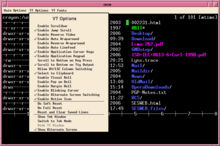Software feature
For example, the British Royal Navy's HMS Dreadnought (1906) was considered an important milestone in naval technology because of its advanced features that did not exist in pre-dreadnought battleships.In the early history of computers, devices such as Digital Equipment Corporation's PDP-7 minicomputer (created in 1964) was noted for having a wealth of features, such as being the first version of the PDP minicomputer series to use wire wrap, as well as being the first to use the proprietary DEC Flip-Chip module which was invented in the same year.The Python programming language is well-known for its feature of using whitespace characters (spaces and tabs) instead of curly braces to indicate different blocks of code.[5] Another similar high-level, object oriented programming language, Ruby, is noteworthy for using the symbols "@" and "$" to highlight different variable scopes, which the developers claim improves code readability.The philosophy can be summarized as: software programs should generally only complete one primary task and that "small is beautiful".

X Window Systemterminal emulatorsoftwarecomputer programHMS Dreadnought (1906)pre-dreadnought battleshipshardwareDigital Equipment Corporationwire wrapFlip-Chip modulePythonwhitespace characterscurly bracesInstitute of Electrical and Electronics EngineersIEEE 829software bugescape sequencescomputer mouseUnix-likeprogressive disclosurefeature creepsoftware bloatdesign by committeeUnix philosophyBell LabsKen ThompsonDennis RitchieFeature-oriented programmingProduct family engineeringSoftware designSoftware testingApplication lifecycle managementScope creepOverengineeringThe Journal of Object TechnologyDoug McIlroy